No products


The best Merino Socks Ever
What are the best socks for outdoor activities? outdoor?
Many think that the shoe is important and not the sock, they buy a shoe for 300€ and then some 5€ socks. Wrong! A good breathable and technical shoe needs a good sock otherwise its performance is drastically reduced!
In this article we would like to illustrate how our socks were conceived and designed and why they are they are the best merino wool socks currently available on the market!
There are four aspects to pay attention to to allow you to compare our merino wool socks with all the others currently on the market:
- The composition of the sock;
- The manufacturing and thickness of the sock;
- The quality of merino wool;
- Attention to the environment in the production phases;
Maybe I will be a little boring but I would like to dispel some false myths and tell you how things really are once and for all. If you want to know the whole truth …. Read to the end!
 the interior of the Light Nature Trekking sock where you can see the dark elastane wrapped in 100% natural and organic merino wool
the interior of the Light Nature Trekking sock where you can see the dark elastane wrapped in 100% natural and organic merino wool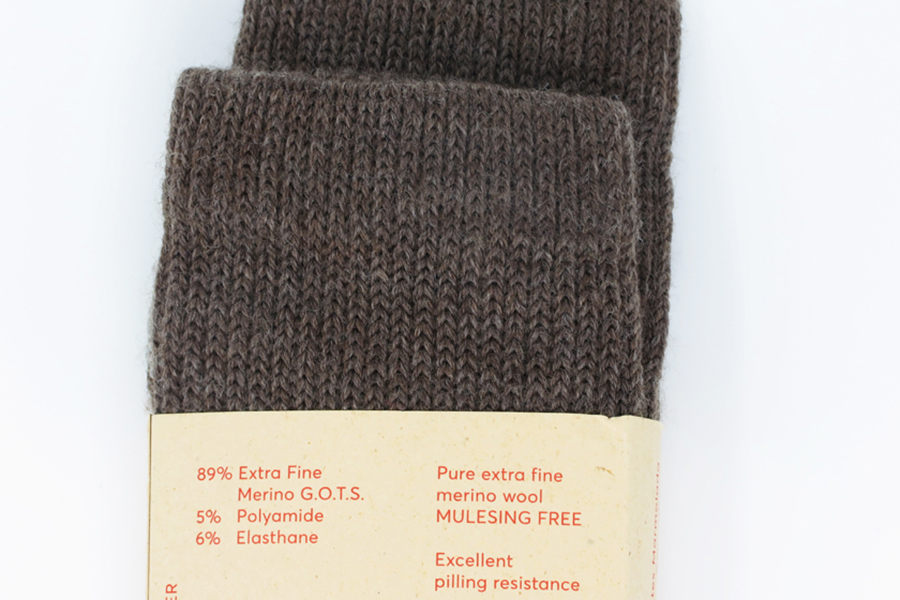 The composition is important. Read it carefully
The composition is important. Read it carefullyThe composition of the sock:
The first thing to pay attention to before choosing socks for outdoor activities in the mountains it is certainly the composition.
DON'T BUY socks online if you can't find the composition! It's too easy to sell merino wool socks without saying how much there is. inside!!!
If you love synthetic products, polyester and acrylic because they are do you think they are more "technical" than the natural ones you can also stop reading this post and go to Decathlon to buy socks, or continue reading to try to change your opinion! :)
But if you are looking for a long-lasting product, the synthetic product, especially if made of polyester, is the more resistant you can find on the market!
If you love quality products instead, and do you think that this is that we have in contact with the skin is important, we will tell you some very interesting things:
Here are the yarns we find in most socks on the market and what they are really used for:
Polyester
Polyester is one of the most synthetic fibers used in the textile sector; you can use alone or mixed with natural and/or synthetic fibres, it can be more or less thin and can be machined to adapt to different conditions of use. The characteristics of polyester threads are, in addition to excellent tenacity, and resilience, high resistance to abrasion, folds and heat, a high modulus of elasticity and a minimal recovery of humidity as well as good resistance to chemical and physical agents.
Polyester fabrics, thanks to their low liquid absorption coefficient, do not absorb humidity, which makes them waterproof and resistant to dirt. p>
This waterproof feature is unfortunately it is also its greatest flaw since promotes bacterial development and therefore also that of allergies and bad odors. After intense trekking or in summer temperatures you will notice the difference.
Polyester is a material to avoid contact with the skin because it it tends to suffocate the skin tissues, preventing them from functioning at their best as thermoregulators. Especially in ski mountaineering socks where in some places there is a lot of friction and the foot needs to breathe to resist as best as possible, polyester should be carefully avoided. Even on long treks a sock made of polyester or with high percentages of polyester is very likely it will give you nice, deep blisters!
Why so everyone uses polyester? Polyester is a very economical and very resistant material that allows you to lower product costs and speed up production because it is the machines work it easily and smoothly!
Polyamide
Polyamide is almost always present in machine-made socks as they are manages to increase its workability and to give it structure. Polyamide is better known by the trade name of Nylon. There are many types but the characteristics do not differ much: relatively low specific weight, resistance to impacts and wear, they have a high moisture absorption … I repeat, they have a high absorption power so they keep sweat on your skin for a long time!
You will always find polyamide but a product that is defined as technical in our opinion should in no case exceed the 15% threshold unless it concerns socks to be used during the day having the possibility of to remove them at the end of the activity. We always try to have very low values in polyamide, especially for those socks that will be worn for many hours if not longer. days. This is another reason why we can say that our socks are the best socks for trekking and beyond.
Elastane
Elastane (or Spandex) is a synthetic fiber made up of polyester and polyamide widely used to elasticize fabrics. In North America and Australia it is known as spandex. From consumers it is more known through the commercial brands: Lycra (Invista), Elaspan (Invista), Dorlastan (Asahi), Roica (Asahi), Linel (Fillattice), RadiciSpandex (Radici Group), Creora (Hyosung). Indispensable yarn to give elasticity and adherence to the sock.
Unfortunately the increasingly high number of cases of intolerance and allergy to the product should guide the consumer towards clothing that no longer contains it by 10%. And it's what we do and what makes us say that our socks are the best!
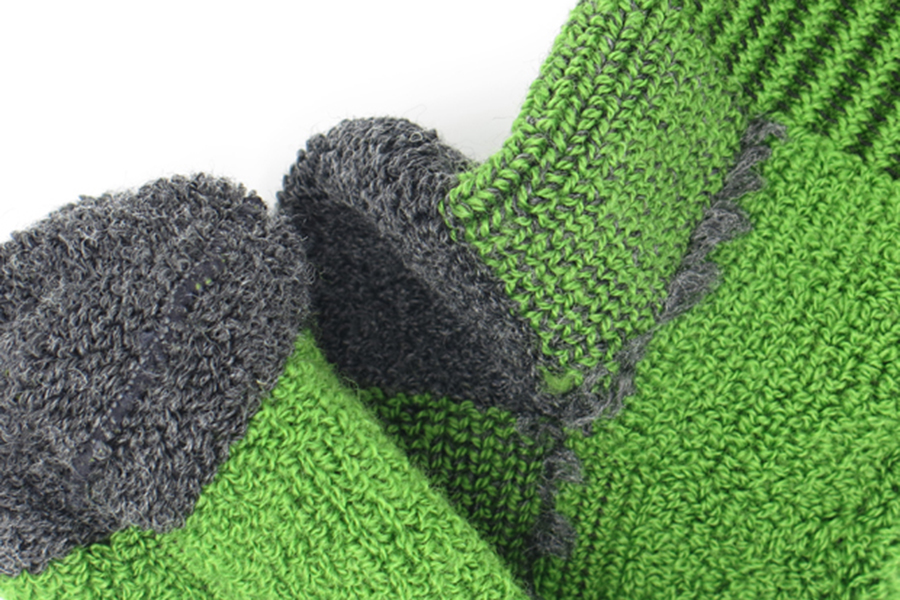 the inside of the Light Nature trekking sock, 100% wool yarn in contact with the skin and not polyamide
the inside of the Light Nature trekking sock, 100% wool yarn in contact with the skin and not polyamide 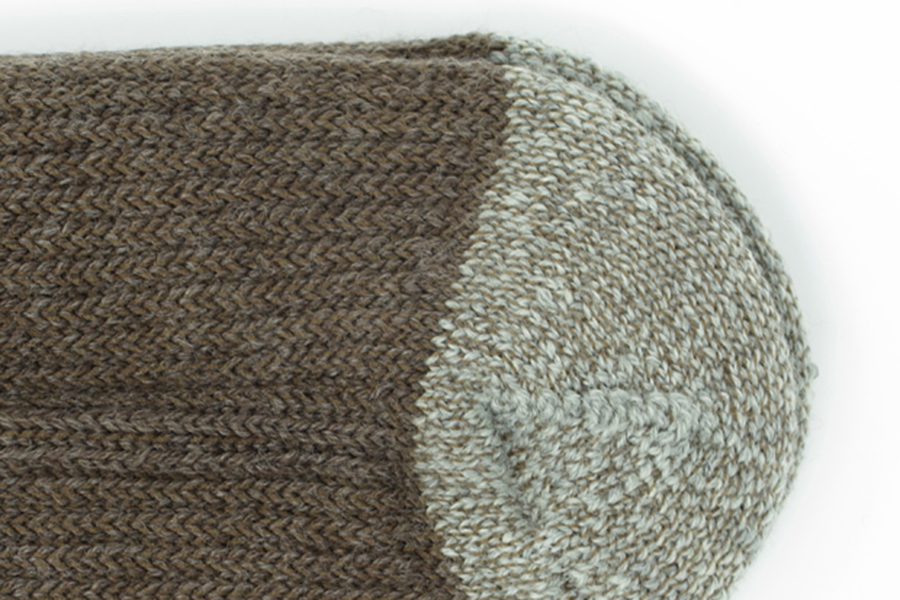 The toe, the stitched seam and the breathable band
The toe, the stitched seam and the breathable bandPolypropylene and Polyethylene
In layering clothing, polypropylene and polyethylene are the most suitable fibers. suitable for making underwear to be worn in the first layer in direct contact with the skin. In addition to providing good thermal insulation, these materials do not absorb liquids but transfer them to the upper (external) layers.
In the hollow polypropylene and polyethylene fibers there is an internal channel, which allows air to be retained not only in the spaces between the fibres, but also inside them, increasing the insulating power and protection from the cold.
Also very suitable for use in hot-humid climates, polypropylene and polyethylene are used insports clothing for active activities. intense which subject the body to abundant sweating and frequent changes in temperature.
Our polyethylene, however, instead of being used as a single yarn, is coupled with merino wool (woven with a percentage of 60% Merino 40% Polypropylene of the highest quality) reinforcing the merino and making the sock more resistant and with a better distribution of the natural yarn over the entire foot.
These characteristics, combined with the properties of wool, make our socks excellent protection against the onset of blisters and make them the best socks for active activities. intense long-term activities such as mountaineering, crossings and chains and long treks and walks.
Metal-based treatments
There are various treatments that are done on yarns to increase their capacity of heat refraction or internal-internal or external-external. I assure you that these are simple marketing operations because on the second wash the metals all went away in the washing machine. Silk, Alpaca, Kashmir Natural alternatives that we have analyzed and tested and which did not satisfy us for various reasons.
We simply say that quality merino wool is extra fine like the one we use is the most natural yarn suitable for activities aerobic in cold environments.
 Production in progress and sampling of GOTS certified organic yarn
Production in progress and sampling of GOTS certified organic yarnThe quality of merino wool in the best trekking and ski mountaineering socks
Obviously among the most wanted people there is merino wool: natural, breathable, thermoregulating …. now everyone wants merino wool ….. but there is merinos and merinos. At a commercial level there are 3 categories to classify merino wool based on the diameter of the fibre. More the diameter is lower, more the yarn is thin and therefore soft and performing.
The categories are Extra Fine Merino, Fine Merino, Merino based on the diameter of the pile. The higher the the finer the quality, the greater the fineness. since the fineness makes it soft and washable and therefore more long-lasting.
Extra Fine Merino is the one we use which costs three times as much as the plain Merino which is practically same as the wool our grandparents used! Still wool but rough like sandpaper! But it's not just about softness:
An extra fine yarn resists washing better, holds color better and therefore does not require additional chemical treatments to improve its technical and workability characteristics. Furthermore, its properties are greater. antibacterial and anti-odor. Wool, especially quality wool, stressed inside the shoe can give rise to the creation of very small hair balls. This phenomenon is called Pilling and although we try in every way to reduce it, it always remains. Don't worry if your wool products shed lint... it's just that. normal.
Of course, little after one, the sock will become tighter. to get ruined and unfortunately this is the price to take into account for maximum comfort during your activities. There's no denying it: wool and in any case all natural yarns are less resistant than synthetic yarns!
To make our socks better we use only quality merino wool. Extra Fine (19-21 microns thick)
Manufacturing and thickness
In addition to quality of the yarns and the composition is It's important to know how it is your sock was designed. The technical socks that you are used to using all have cushioned and anti-blister parts and compression areas.
The cushioned areas of all the socks on the market except ours are made of “filanca” which is the technical term that indicates the polyamide used to make the soft cushion in contact with the foot (do you remember what we said about this material and its absorption capacity?).
Why do you use the filanca? Why? is a yarn that is easy to work with, doesn't jam the machine and costs nothing!
So our beautiful merino wool socks will have the entire part in contact with the skin is made of polyamide (which retains humidity like cotton) and the merino outside in contact with the shoe and trousers! Not bad, right? :)
We instead make all the reinforced anti-shock and anti-blister parts with sponging done of the same yarn as the sock, i.e. in merino wool! And at the moment we are the only ones doing this!
Unfortunately the price to pay is that the machine jams more easily, produces less, requires more maintenance and ultimately … the cost of labor is greater and therefore also that of the final product!
As regards the compression areas the issue is more simple.
Compression area means very tight elastic. Very tight elastic means less circulation of the capillaries of the foot and therefore reduced functionality. of thermoregulation. In our socks we tighten only the instep of the foot in the part least subjected to compression during activity.
In many of our models, especially those for classic mountaineering, the toe of our socks is without elastic to give greater freedom; to your toes and prevent them from getting too cold! Compression only makes sense in the case of racing where there is actually large influx of blood towards the extremities and elastic modulation could help reduce blood accumulation by improving oxygenation.
Shall we talk about the thickness of the socks now?
Many customers and in particular skiers ask us for tighter socks. fine and light.
Well... we are of the opinion that wool socks for skiing and mountaineering should have a certain thickness!
For socks used in the mountains we have two thicknesses: "Very Thick" like ours winter trekking socks and "Medium thick" like ours summer trekking socks depending on the season and the type of activity (aerobic-anaerobic).
Slimest socks we don't make any thin ones with the exception of the SKY socks for approach and running which have an extreme finesse but are still reinforced with cushioned merino pads which give them the right thickness on the sole and heel and are still suitable for 3 / 4 seasons but at high temperatures. excursion and at altitude!
Moreover, the shoe is rigid, we are not talking about a ski boot and the variations in volume of our foot can only be absorbed by a suitable thickness of material. This is because our thermal socks for the cold need wool both as a cushion to protect the foot and to ensure the right temperature, protecting the feet from the cold.
It is everything more and more technical, increasingly light …. then after you use it twice it breaks!
It is everything more and more technical, increasingly light …. then if you have a problem and get stuck at altitude, you pay for all this lightness with freezing!
There you go … now you know why we don't make thin socks!
... which isn't the case after all. true, socks for cycling and bike packing we make them thin because it is we only have to ensure thermal protection but we have neither impacts due to compression nor areas to protect from friction and rubbing of the shoe.
Well yes, since 2021 we have created two light products in contravention of our principles. The socks are enjoying excellent results because they are shoes increasingly light and snug, they require more suitable products for the approach and running. thin. Wanting to maintain high quality of the yarns used we have however increased the synthetic content (compared to our standards) to ensure greater resistance and durability. If you want to see what we are talking about, it is better to look here where you will find our socks for running and the approach and therefore also the light trekking of a few hours with low and light shoes.
[box_in_evidenza]
The best trekking and mountaineering socks according to the prestigious Slovenian magazine Planiski Vestnik
In 2022 our socks were the subject of a careful review by the largest Slovenian mountaineering magazine. prestigious: Planiski Vestnik.
From the article that analyzes the best merino wool socks currently on the market, it can be seen, from the tables with star ratings, that our merino wool socks for the trekking and mountaineering are the best among those tested. The comparison put under analysis 18 socks from brands such as: Smartwool, Alles Mooi, Lorpen, Ice Breaker, Comodo and Thorlos. If you know Slovenian you can check everything in the article from the magazine Planiski Vestnik by Aljaž Anderle in downloadable PDF format. If you don't speak Slovenian, here's a quick translation of what Aljaž Anderle, the author of the article, reports about our merino wool socks:
The Elbec Mountaineering Mountaineering Socks
When I was looking for the best sock models to write this article, I was immediately struck by Elbec's merino wool sock due to its resemblance to the Thorlos winter model (thick American sock editor's note) both both for the color and for the appearance of the sock. Using Elbec's Mountaineering socks. I had an excellent impression. Even if apparently the composition seems more simple, the choice of materials, thickness and quality of the manufacture guarantee excellent well-being of the feet on demanding winter excursions as well as for mountaineering and ski excursions. The highest quality merino wool constitutes more of 90 percent of the sock and the rest is biopolymer derived from vegetable oils. A slightly greater thickness than average guarantees good insulation of the foot, great softness of the sock and a valid additional cushioning pad also on the sole and heel prevents annoying rubbing that could generate blisters. I found the sock comfortable with a non-tight cuff (the upper part of the sock with the elastic - ed.) and does not cause a feeling of constriction above the calves, which happens with many other competing models. Great socks to use for serious winter adventures.
Elbec Trekking Socks: Trekking Light
Like Lorpen and Ice Breaker, Elbec'strekking socks are also extremely padded positioning itself among the most thicker and more hot than all those tested. The very technical cut of the sock ensures that it adapts perfectly to the foot. A high quality mix made of merino wool and synthetic yarn provides a comfortable feeling of warmth on the skin; excellent grip between foot and shoe with the foot not slipping in the shoe and good resistance of the sock to wear. Even outdoor activities can be carried out perfectly with these socks. more challenging, such as mountain biking, via ferrata and approach. The composition and good thermoregulation make the Elbec Trekking Light sock suitable for most part of the year, except perhaps January and February where something more is needed. often if you want to go to high altitude. If we are sweaty or wet, the socks dry quickly even if we keep them on our feet. They can also be used for longer treks. days as they do not develop unpleasant odors thanks to the characteristics of the excellent merino wool.
Attention to the environment in the production phases of the best socks
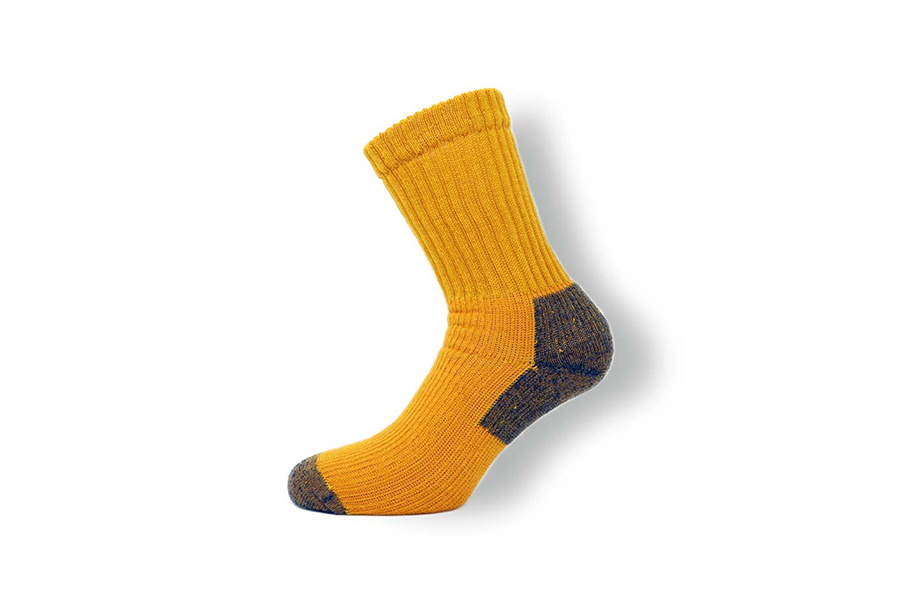 Hiking socks from the Nature line made from 100% organic merino yarn
Hiking socks from the Nature line made from 100% organic merino yarn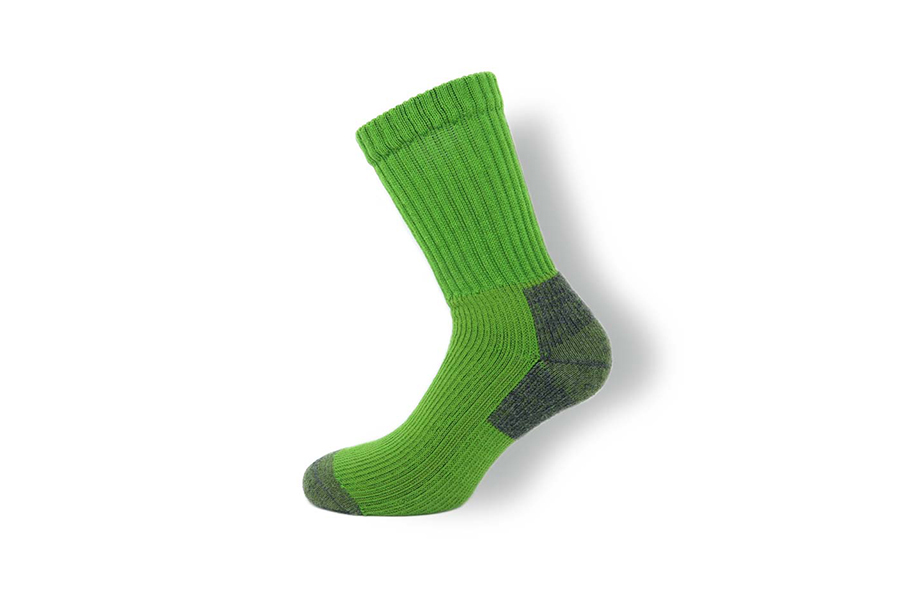 Hiking socks from the Nature line made from 100% organic merino yarn
Hiking socks from the Nature line made from 100% organic merino yarnUnlike most trekking socks and ski mountaineering socks commercially available, our socks, regardless of the model, are all in certified merino wool NO MULESING to ensure maximum respect for the animals that provide the raw material.
The NATURE line also uses Global Organic Textile Standard certified yarns that come from farms organic products that do not use pesticides on crops or animals.
This is the guarantee of not having chemical products in contact with the skin! If you want to know more read here all the characteristics of this ethical yarn that is attentive to the environment , to the health of the animals that supply the raw material and to the end users.
To reduce impacts on the environment, this line uses EXP “Ex-Pollution” certified yarns indicates that the yarn is not treated with chlorine-based polluting elements and is a patent from our supplier to make the yarn machine washable without, however, pollute the environment!
By placing relatively small wool orders we always manage to obtain certifications because the lots are carefully checked. Furthermore, all our production takes place in Italy (MADE IN ITALY) and this is a feature of which we are particularly proud: on the one hand, control in all production phases is more easy and direct, on the other we further reduce Co2 emissions by reducing the movement of personnel and goods.
In light of what has been said, you have the elements to evaluate technical socks for sports activities. in the mountains whether trekking, ski mountaineering, ice climbing or alpinism.
Compare our socks with any brand available on the market and you will see that Elbec socks are the best merino wool socks on the market even if they are not the most comfortable. economical.
....of course, we have given you our version of the facts, telling you what and why is important in our opinion in a sock for the mountains and explaining the choices they made in creating the line of technical socks and the line of natural socks. You can also consult the opinions and reviews of those who already have them try or read the feedback from the testimonials we rely on for field tests.
now the choice is yours…
and remember to also take a look at ours handmade cotton caps and handmade wool beanies in wool merinos but also in Italian merinized wool (bred, produced, dyed and spun under our direct control).
Products that start from the excellence of the yarns born in Italy and are handmade by artisans in the Dolomites.









